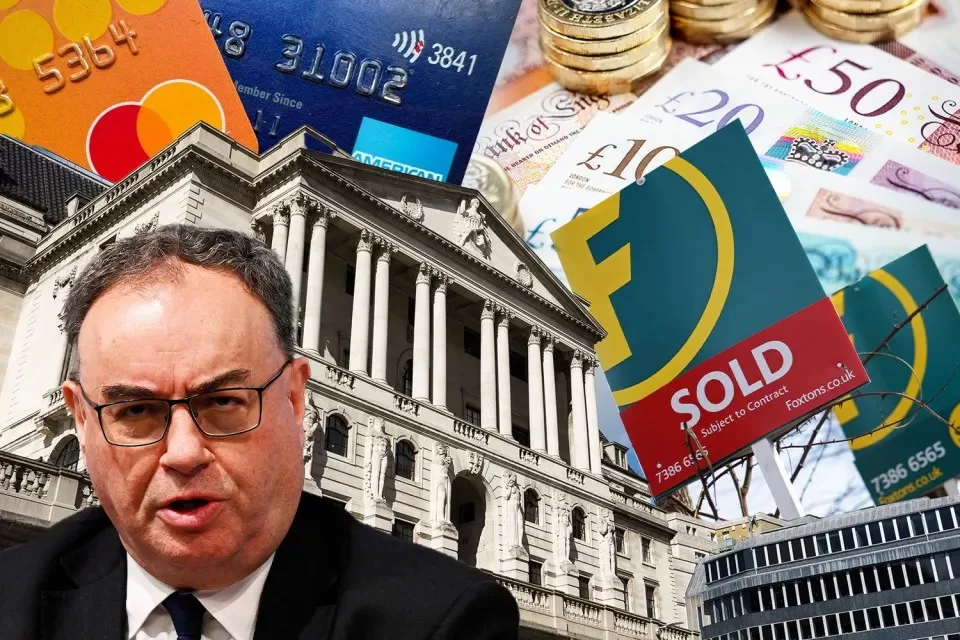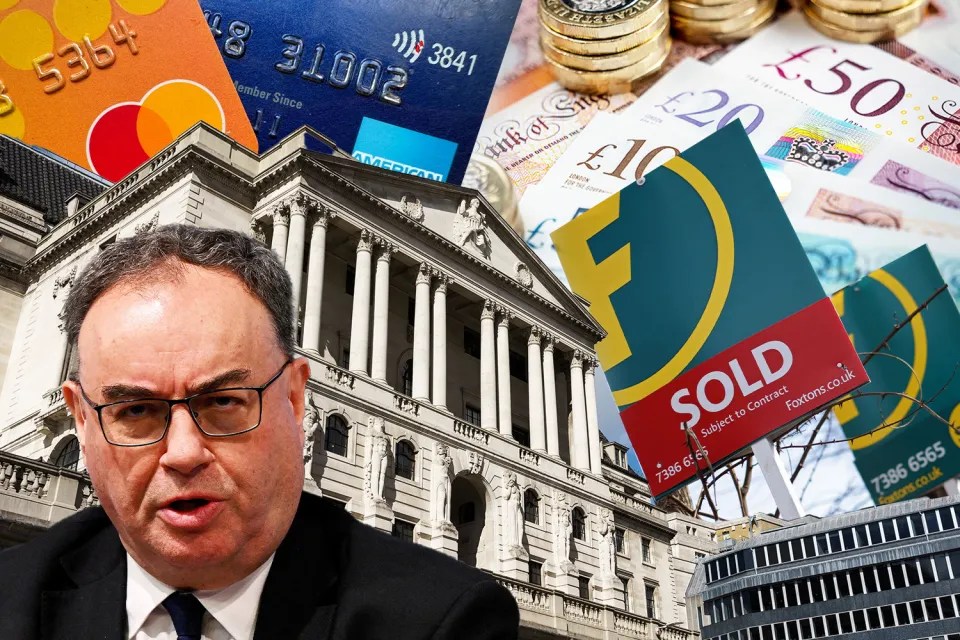SUB 3% mortgages could be on the cards as the Bank of England hints at more “aggressive” rate cuts.
It comes after a host of major lenders have made reductions to rates.
The news follows Governor Andrew Bailey stating the Bank of England could be “more aggressive” in cutting interest rates.
Mr Bailey said that if inflation remains in check the Bank might be able to be “more activist” over reducing borrowing costs.
The comments have led several experts to bring forward predictions for interest rate cuts.
British interest rates currently sit at 5%. The rate – which is used by banks to determine the interest on mortgages and loans – was reduced from 5.25% in August.
READ MORE ON BANK OF ENGLAND
Members of the Bank’s Monetary Policy Committee (MPC) voted to keep rates at 5% at the latest vote in September, but economists are currently pricing in another reduction at next month’s meeting.
Gabriel McKeown, head of macroeconomics at Sad Rabbit Investments said: “Governor Bailey’s bombshell comments have opened the floodgates to more aggressive rate cuts, with the prospect of sub-3% mortgages, once dismissed as a pipe dream, now emerging as a tantalising possibility for homeowners.
“These views significantly depart from earlier comments advocating for gradual rate reductions, leading swap rates to fall sharply.
“Markets are now pricing in an all but certain chance of a rate cut at the Bank’s next meeting in November.”
He added that the prospect of reduced borrowing costs and increased competition in the mortgage market should help drive the rate-slashing momentum towards the end of 2024.
Elsewhere, Adam Stiles managing director at Helix Financial Partners pointed out that Skipton Building Society is already offering a sub-3% product transfer mortgage at 2.89% – although it comes with a hefty 3% fee and is up to 60% loan-to-value.
Mr Stiles told The Sun: “If the Bank of England delivers one more rate cut, which seems likely after Andrew Bailey’s hints this week, that could quickly feed through into swap rates, which determine lenders’ fixed rates.
“However, we are only likely to see sub-3% rates at lower loan-to-values. We don’t expect to see them widespread at higher loan-to-values until we have a few more rate cuts, which is possible by mid-2025.”
Dariusz Karpowicz, who is director at Albion Financial Advice, said that it’s not “unrealistic” that we’ll see rates drop below 3%.
He said: “All the signs point to it – some rates below 3%! Swap rates are falling, and Andrew Bailey is hinting at a potential decrease. The economic outlook is improving, and lenders are already trimming rates almost every week.
“It’s not unrealistic to see rates dipping below 3% for lower LTVs before year’s end. Of course, only an unexpected ‘black swan’ event could derail this positive momentum.”
What is happening to swap rates?
A swap rate is a rate based on what the markets think interest rates will be in the future.
If the rates rise, then mortgage lenders will look to increase their rates so that they don’t lose out.
The BoE comments have had a “positive” impact on swap rates.
A number of lenders have already announced repricing and more are expected to follow suit, according to mortgage broker SPF Private Clients.
Mark Harris, chief executive of mortgage broker SPF Private Clients, says: “A more aggressive approach to rate reductions has been welcomed by the markets, with swaps falling on the back of the Governor’s comments, which should feed through to even lower mortgage pricing.
“A number of lenders are already in the process of repricing – Coventry [building society]’s two and five-year fixes which top the best buy tables at 3.89 and 3.69% respectively are being pulled tonight, while HSBC is repricing downwards today and NatWest and Barclays are repricing tomorrow.
“Santander is also repricing tomorrow and is likely to top the ‘best buys’ with its new deals – a two-year purchase option at 3.84% for those borrowing 60% loan-to-value and a five-year fix at 3.68%, also at 60% LTV.”
He said the ongoing rate war among lenders is “great news” for borrowers as there are some “really compelling” deals being launched, which will go some way to helping affordability.
Different types of mortgages

We break down all you need to know about mortgages and what categories they fall into.
A fixed rate mortgage provides an interest rate that remains the same for an agreed period such as two, five or even 10 years.
Your monthly repayments would remain the same for the whole deal period.
There are a few different types of variable mortgages and, as the name suggests, the rates can change.
A tracker mortgage sets your rate a certain percentage above or below an external benchmark.
This is usually the Bank of England base rate or a bank may have its figure.
If the base rate rises, so will your mortgage but if it drops then your monthly repayments will be reduced.
A standard variable rate (SVR) is a default rate offered by banks. You usually revert to this at the end of a fixed deal term, unless you get a new one.
SVRs are generally higher than other types of mortgage, so if you’re on one then you’re likely to be paying more than you need to.
Variable rate mortgages often don’t have exit fees while a fixed rate could do.
What are lenders doing?
This week five more mortgage lenders have announced cuts to mortgage rates.
Barclays, HSBC, Halifax, Santander and NatWest are all making several rate reductions across a range of mortgage deals.
It follows a recurring theme of cuts over the past few months.
Since the beginning of July, the lowest five-year fixed rate mortgage has fallen from 4.28% to 3.69%.
Elsewhere, the lowest two-year fix has fallen from 4.68% to 3.89%.
Barclays was first off the bat, announcing cuts that mainly affect first-time buyers and home movers, including some sub-4% deals for borrowers with the biggest deposits.
Its lowest two-year fix for buyers with a 40% deposit or more fell to 3.99% from today.
HSBC has implemented another wave of mortgage rate cuts.
It says all its residential and buy-to-let deals have now been reduced by up to 0.16 percentage points.
HSBC confirmed its two-year and five-year fixed mortgages for both home movers and first-time-buyers have been cut by up to 0.25 percentage points.
Its lowest five-year fix for those remortgaging with at least a 40% equity is now priced at 3.83%.
Halifax was next up to announce a cut taking place from today.
The UK’s biggest lender cut mortgage rates on selected products by up to 0.11 percentage points for home movers and first-time buyers.
Halifax also confirmed reductions of up to 0.24 percentage points for homeowners due to remortgage.
Santander and NatWest also announced a wide range of range cuts for today.
Santander’s fixed-rate deals dropped by 0.29 percentage points for home buyers and those remortgaging.
It means Santander now offers the lowest five-year fix on the market for home buyers purchasing with the biggest deposits.
All its mortgage rates for new build purchases are also reducing by up to 0.19% alongside all its buy-to-let fixed rates, which are dropping by up to 0.17%
Meanwhile, NatWest is also executing some healthy cuts across fixed-rate deals aimed at home buyers and remortgagers.
How to get the best deal on your mortgage
IF you’re looking for a traditional type of mortgage, getting the best rates depends entirely on what’s available at any given time.
There are several ways to land the best deal.
Usually the larger the deposit you have the lower the rate you can get.
If you’re remortgaging and your loan-to-value ratio (LTV) has changed, you’ll get access to better rates than before.
Your LTV will go down if your outstanding mortgage is lower and/or your home’s value is higher.
A change to your credit score or a better salary could also help you access better rates.
And if you’re nearing the end of a fixed deal soon it’s worth looking for new deals now.
You can lock in current deals sometimes up to six months before your current deal ends.
Leaving a fixed deal early will usually come with an early exit fee, so you want to avoid this extra cost.
But depending on the cost and how much you could save by switching versus sticking, it could be worth paying to leave the deal – but compare the costs first.
To find the best deal use a mortgage comparison tool to see what’s available.
You can also go to a mortgage broker who can compare a much larger range of deals for you.
Some will charge an extra fee but there are plenty who give advice for free and get paid only on commission from the lender.
You’ll also need to factor in fees for the mortgage, though some have no fees at all.
You can add the fee – sometimes more than £1,000 – to the cost of the mortgage, but be aware that means you’ll pay interest on it and so will cost more in the long term.
You can use a mortgage calculator to see how much you could borrow.
Remember you’ll have to pass the lender’s strict eligibility criteria too, which will include affordability checks and looking at your credit file.
You may also need to provide documents such as utility bills, proof of benefits, your last three month’s payslips, passports and bank statements.
Does everyone agree sub-3% deals are looming?
In short, no. Not everyone agrees that these -3% deals are on the way.
This is largely due to positive moves being scuppered by global events and the fact that interest rates are notoriously hard to predict.
Not to mention that Labour’s first Budget is just a few weeks away.
Jack Tutton, director at SJ Mortgages told us: “If the pace of rate reductions that we are currently enjoying continues until the end of the year, sub-3% rates would be a real possibility.
“However, there are many things that could derail this optimism. The Autumn Budget will be the biggest hurdle. The decisions that the Chancellor takes will be a make-or-break moment for interest rates.”
Meanwhile, Elliott Culley, who is the director at Switch Mortgage Finance, says he believes there is a “slim” chance of rates hitting below 3%.
He said: “It would be a huge turnaround if mortgage rates were to fall below 3% by the end of the year.
“However, I would expect the chances of this happening being slim based on current domestic and world events.”
Others are pretty certain this will not be the case.
“With all the uncertainty ahead of the upcoming Budget, there is more chance of Bruno Fernandes getting Player of the Month than rates returning to sub-3%,” David Stirling Independent Financial Advisor at Mint Mortgages & Protection said.
“With Middle East issues escalating and causing volatility in oil prices as we enter winter, added to the potential tax hardships to come, it’s hard to see rates normalising below 3% this year.”
Do you have a money problem that needs sorting? Get in touch by emailing [email protected].
Plus, you can join our Sun Money Chats and Tips Facebook group to share your tips and stories

